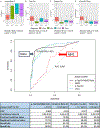Alzheimer Disease Cerebrospinal Fluid Biomarkers in a Tertiary Neurology Practice
- PMID: 38935019
- PMCID: PMC11584168
- DOI: 10.1016/j.mayocp.2023.12.024
Alzheimer Disease Cerebrospinal Fluid Biomarkers in a Tertiary Neurology Practice
Abstract
Objective: To evaluate the performance of Alzheimer disease (AD) cerebrospinal fluid (CSF) biomarkers in a tertiary neurology clinic setting with high frequency of non-AD cases, including normal pressure hydrocephalus (NPH).
Methods: There were 534 patients who underwent AD CSF biomarkers (Roche Elecsys Aβ42, p-Tau181, total-Tau) from April 1, 2020, through April 23, 2021. A behavioral neurologist blinded to CSF results assigned a clinical diagnosis retrospectively on the basis of consensus criteria, and a neuroradiologist blinded to the diagnosis and CSF studies graded brain magnetic resonance images for indicators of CSF dynamics disorders. Associations between biomarkers, diagnoses, and imaging were assessed by χ2, analysis of covariance, and linear regression methods.
Results: Median age at time of testing was 67 years (range, 19 to 96 years), median symptom duration was 2 years (range, 0.4 to 28 years), and median Short Test of Mental Status score was 30 (range, 0 to 38). Clinical diagnoses significantly correlated with different CSF biomarker values (χ2=208.3; P=10e-4). p-Tau181/Aβ42 ratios above 0.023 positively correlated with Alzheimer dementia (more than individual measures). This ratio also had the best performance for differentiating Alzheimer dementia from NPH (area under the curve, 0.869). Imaging markers supportive of CSF dynamics disorders correlated with low Aβ42, p-Tau181, and total-Tau.
Conclusion: In a heterogeneous clinical population, abnormal p-Tau181/Aβ42 ratios (>0.023) have the strongest association with Alzheimer dementia and probably represent a comorbid AD pathologic component in persons clearly matching non-AD neurodegenerative syndromes. Altered CSF dynamics were associated with lower concentrations of AD CSF biomarkers regardless of clinical diagnosis, but the ratio compensates for these changes. In the appropriate clinical setting, an isolated abnormal Aβ42 should prompt consideration of NPH.
Copyright © 2024 Mayo Foundation for Medical Education and Research. Published by Elsevier Inc. All rights reserved.
Figures



References
MeSH terms
Substances
Grants and funding
LinkOut - more resources
Full Text Sources
Medical
Miscellaneous

